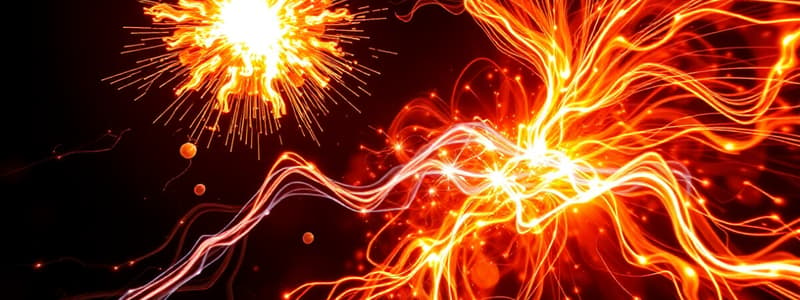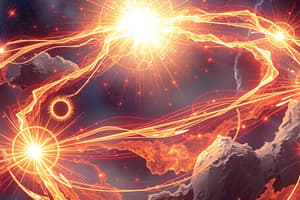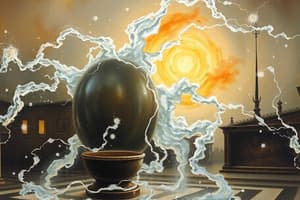Podcast
Questions and Answers
What is the formula for calculating Kinetic Energy?
What is the formula for calculating Kinetic Energy?
- KE = mv
- KE = mv²
- KE = 1/2 mv² (correct)
- KE = mgh
Which law states that for every action, there is an equal and opposite reaction?
Which law states that for every action, there is an equal and opposite reaction?
- First Law of Motion
- Law of Universal Gravitation
- Second Law of Motion
- Third Law of Motion (correct)
What does Ohm’s Law describe?
What does Ohm’s Law describe?
- Voltage is equal to power times current.
- Resistance is proportional to voltage.
- Power is equal to current times voltage.
- Current is equal to voltage divided by resistance. (correct)
Which principle explains that energy cannot be created or destroyed?
Which principle explains that energy cannot be created or destroyed?
Which statement is true regarding the Second Law of Thermodynamics?
Which statement is true regarding the Second Law of Thermodynamics?
What is described by the concept of wave-particle duality in Quantum Mechanics?
What is described by the concept of wave-particle duality in Quantum Mechanics?
Which force is responsible for holding protons and neutrons together in the atomic nucleus?
Which force is responsible for holding protons and neutrons together in the atomic nucleus?
What defines a mechanical wave?
What defines a mechanical wave?
Flashcards are hidden until you start studying
Study Notes
Key Concepts in Physics
-
Fundamental Forces
- Gravitational Force: Attracts masses.
- Electromagnetic Force: Acts between charged particles.
- Strong Nuclear Force: Holds protons and neutrons in the atomic nucleus.
- Weak Nuclear Force: Responsible for radioactive decay.
-
Newton’s Laws of Motion
- First Law: An object at rest stays at rest; an object in motion remains in motion unless acted on by an external force.
- Second Law: F = ma (Force equals mass times acceleration).
- Third Law: For every action, there is an equal and opposite reaction.
-
Energy Principles
- Kinetic Energy: Energy of motion (KE = 1/2 mv²).
- Potential Energy: Energy stored due to position (PE = mgh).
- Conservation of Energy: Energy cannot be created or destroyed, only transformed.
-
Thermodynamics
- Zeroth Law: If two systems are in thermal equilibrium with a third system, they are in equilibrium with each other.
- First Law: Energy conservation in thermodynamic processes (ΔU = Q - W).
- Second Law: Entropy of an isolated system always increases; heat cannot spontaneously flow from cold to hot.
- Third Law: As temperature approaches absolute zero, the entropy of a perfect crystal approaches zero.
-
Waves and Oscillations
- Wave Properties: Wavelength, frequency, amplitude, speed.
- Types of Waves:
- Mechanical: Requires a medium (e.g., sound waves).
- Electromagnetic: Does not require a medium (e.g., light waves).
- Superposition Principle: When two waves overlap, the resulting wave is the sum of the two.
-
Electricity and Magnetism
- Ohm’s Law: V = IR (Voltage = Current x Resistance).
- Circuit Components: Resistors, capacitors, inductors.
- Faraday's Law: A changing magnetic field induces an electromotive force (EMF).
- Ampère's Law: Magnetic field around a current-carrying conductor.
-
Modern Physics
- Theory of Relativity:
- Special Relativity: Time and space are interwoven; speed of light is constant in a vacuum.
- General Relativity: Gravity is a curvature of spacetime.
- Quantum Mechanics:
- Wave-particle duality: Particles exhibit properties of both waves and particles.
- Heisenberg Uncertainty Principle: Cannot simultaneously know both the position and momentum of a particle.
- Theory of Relativity:
-
Applications of Physics
- Engineering: Structural, mechanical, electrical, aerospace.
- Medicine: Imaging techniques like MRI and ultrasound.
- Environmental Science: Understanding climate change and renewable energy sources.
Units of Measurement
- Length: Meter (m)
- Mass: Kilogram (kg)
- Time: Second (s)
- Force: Newton (N = kg·m/s²)
- Energy: Joule (J = N·m)
Important Constants
- Speed of Light (c): 299,792,458 m/s
- Gravitational Constant (G): 6.674 × 10⁻¹¹ m³/kg·s²
- Planck's Constant (h): 6.626 × 10⁻³⁴ J·s
This structure provides a clear and concise overview of fundamental topics in physics, facilitating easier study and review.
Fundamental Forces
- Gravitational Force: Attracts objects with mass. Always attractive, weakens with distance.
- Electromagnetic Force: Acts between electrically charged particles. Attractive or repulsive depending on charges, weakens with distance.
- Strong Nuclear Force: Holds protons and neutrons together in an atomic nucleus, strongest force, acts over very short distances.
- Weak Nuclear Force: Responsible for radioactive decay, weaker than strong nuclear force, acts over short distances.
Newton’s Laws of Motion
- First Law (Inertia): An object at rest remains at rest, and an object in motion remains in motion with constant velocity, unless acted upon by a net force.
- Second Law: Force is equal to mass times acceleration (F=ma). A larger force results in greater acceleration, and a greater mass requires a larger force for the same acceleration.
- Third Law: For every action, there is an equal and opposite reaction. When you push a wall, the wall pushes back on you with equal force.
Energy Principles
- Kinetic Energy (KE): Energy of motion, determined by the object’s mass and velocity.
- Potential Energy (PE): Stored energy due to an object’s position or configuration, includes gravitational potential energy (determined by height) and elastic potential energy (determined by stretching or compressing a spring).
- Conservation of Energy: Energy cannot be created or destroyed, only transformed from one form to another.
Thermodynamics
- Zeroth Law: Two systems in thermal equilibrium with a third system are in thermal equilibrium with each other. Objects at the same temperature are in thermal equilibrium.
- First Law: Energy is conserved in thermodynamic processes. The change in internal energy (ΔU) of a system is equal to the heat (Q) added to the system minus the work (W) done by the system.
- Second Law: Entropy (a measure of disorder) of an isolated system always increases over time. This means that heat flows spontaneously from hot to cold, never the other way around.
- Third Law: As the temperature of a system approaches absolute zero (-273.15 °C or 0 Kelvin), the entropy of the system approaches a minimum value.
Waves and Oscillations
- Wave Properties:
- Wavelength (λ): Distance between two successive crests or troughs.
- Frequency (f): Number of waves passing a point per second.
- Amplitude (A): Maximum displacement from the equilibrium position.
- Speed (v): How fast the wave travels, related to wavelength and frequency by the equation v = fλ.
- Types of Waves:
- Mechanical: Requires a medium to travel (like sound waves).
- Electromagnetic: Does not require a medium (like light waves).
- Superposition Principle: When two or more waves overlap, the resulting wave is the sum of the individual waves at each point in space.
Electricity and Magnetism
- Ohm’s Law: Voltage (V) across a conductor is directly proportional to the current (I) through it, with resistance (R) being the constant of proportionality.
- Circuit Components:
- Resistors: Resist the flow of current.
- Capacitors: Store electrical energy in an electric field between two conductive plates.
- Inductors: Resist changes in current due to magnetic fields.
- Faraday’s Law: A changing magnetic field induces an electromotive force (EMF), which can drive a current in a conductor.
- Ampère’s Law: A current-carrying conductor creates a magnetic field around it, and the strength and direction of the field are determined by the magnitude and direction of the current.
Modern Physics
- Theory of Relativity:
- Special Relativity: Time and space are interconnected and relative to the observer's motion. The speed of light in a vacuum is constant for all observers.
- General Relativity: Gravity is a curvature of spacetime caused by the presence of mass or energy.
- Quantum Mechanics:
- Wave-particle duality: Particles exhibit properties of both waves and particles, such as light behaving like both a wave and a stream of photons.
- Heisenberg Uncertainty Principle: It is impossible to simultaneously know both the position and momentum of a particle with perfect accuracy.
Units of Measurement
- Length: Meter (m) - Mass: Kilogram (kg) - Time: Second (s) - Force: Newton (N) - Energy: Joule (J)
Important Constants
- Speed of Light (c): 299,792,458 m/s
- Gravitational Constant (G): 6.674 × 10⁻¹¹ m³/kg·s²
- Planck's Constant (h): 6.626 × 10⁻³⁴ J·s
Studying That Suits You
Use AI to generate personalized quizzes and flashcards to suit your learning preferences.




